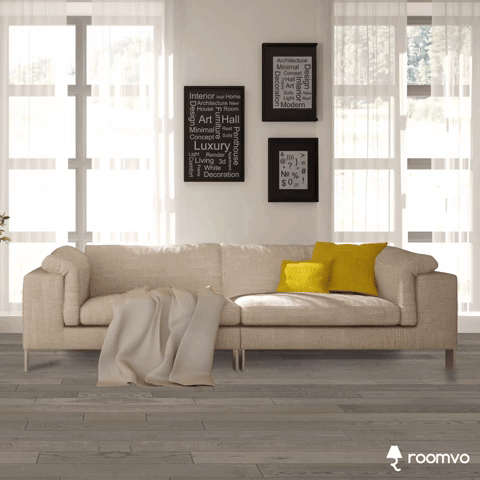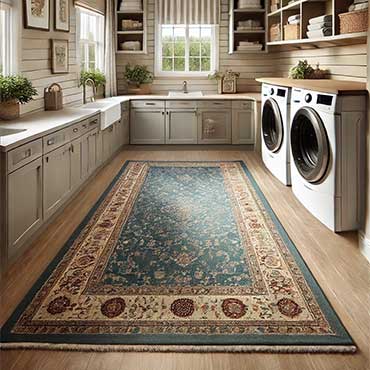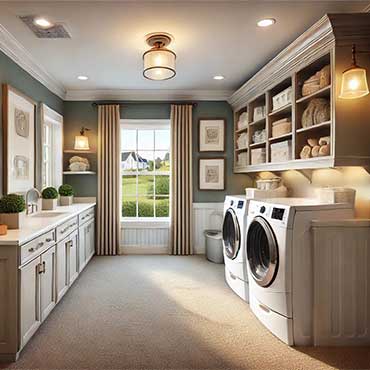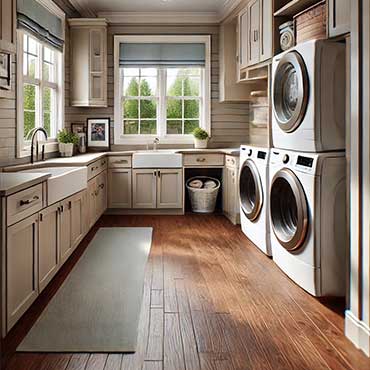
Would You Recommend Using foot traffic in the Laundry Room?
A Marriage of Functionality and Style: Ceramic Tile in Laundry Room Design
The laundry room is a hub of utility and practicality, but its potential as a designed space shouldn't be underestimated. Incorporating ceramic tile into the laundry room elevates it from a purely functional area to one that complements and enhances the home’s aesthetic. Known for its durability, moisture resistance, and versatility, ceramic tile is a frontrunner for this high-traffic, high-humidity space. However, as with any design choice, understanding its impact on various factors is crucial for interior designers and decorators aiming to create cohesive, efficient spaces.
Let’s dive into the unique aspects of ceramic tile and explore its pros and cons for the laundry room. By addressing nine key design considerations, this article will guide you in determining if ceramic tile is the ideal flooring material for your next project.
1. Room Purpose
The laundry room demands materials that can withstand moisture, wear, and frequent cleaning. Ceramic tile excels in this regard, offering:
- Pros: High water resistance prevents warping or staining, a common issue in laundry rooms prone to spills or leaks. It is also highly durable, standing up to the weight of heavy appliances and constant foot traffic.
- Cons: While practical, ceramic tile can be cold and hard underfoot, which may detract from comfort during prolonged use unless paired with area rugs or underfloor heating.
By meeting the room’s functional needs while offering a polished look, ceramic tile is an excellent contender for laundry rooms prioritizing utility without sacrificing style.
2. Design Style
Ceramic tile’s versatility allows it to adapt to various design aesthetics, making it a designer's dream.
- Pros: Available in countless colors, patterns, and textures, ceramic tile can complement a range of styles, from farmhouse to ultra-modern. For example, neutral-toned tiles provide a seamless foundation for minimalist spaces, while bold patterns can create visual interest in eclectic designs.
- Cons: Overly intricate patterns or bold colors may overpower smaller laundry rooms, requiring a careful balance to maintain harmony with other decor elements.
When chosen thoughtfully, ceramic tile enhances the laundry room’s design narrative, contributing to a cohesive and stylish interior.
3. Durability
Durability is a cornerstone for laundry room flooring, and ceramic tile is built to last.
- Pros: Resistant to scratches, dents, and stains, ceramic tile can endure years of heavy use without showing wear. This makes it ideal for laundry rooms that double as mudrooms, where dirt and debris are more likely to accumulate.
- Cons: The grout lines between tiles can discolor over time if not properly maintained, necessitating occasional resealing.
With minimal maintenance, ceramic tile remains a long-lasting option that retains its visual appeal.
4. Moisture Exposure
Given the high humidity and potential for water spills, the laundry room demands flooring that won’t compromise under moisture.
- Pros: Ceramic tile’s impervious surface and water-resistant properties prevent mold, mildew, and water damage, even in the most humid conditions.
- Cons: Poor installation or subpar grouting can create vulnerabilities to water seepage. Ensuring a professional installation is essential to maximize performance.
Ceramic tile is a practical choice for combating moisture challenges while maintaining aesthetic appeal.
5. Budget
Budget is often a critical factor in material selection.
- Pros: Ceramic tile offers an impressive range of options at various price points, making it accessible for both cost-conscious and luxury designs. Its durability ensures value over time, reducing the need for replacements.
- Cons: Installation costs can be higher compared to some alternative materials, particularly if custom layouts or intricate patterns are used.
Balancing quality with cost, ceramic tile delivers long-term savings and aesthetic value.
6. Subfloor Condition
The success of ceramic tile installation depends heavily on the condition of the subfloor.
- Pros: When installed on a level, stable subfloor, ceramic tile creates a flawless, polished surface that enhances the room’s overall aesthetic and functionality.
- Cons: Uneven or poorly prepared subfloors can lead to cracking or loose tiles. Addressing these issues beforehand may increase project costs and timelines.
Proper preparation ensures ceramic tile performs optimally and maintains its visual integrity.
7. Eco-Friendliness
Sustainability is a growing priority in modern design.
- Pros: Made from natural materials like clay, ceramic tile is eco-friendly and often incorporates recycled content. Its longevity further minimizes environmental impact by reducing waste.
- Cons: Some manufacturing processes can be energy-intensive, making it important to source tiles from eco-conscious suppliers.
Ceramic tile aligns with sustainable design goals, contributing to a greener future.
8. Soundproofing/Insulation
Laundry rooms benefit from sound-dampening materials to reduce noise from appliances.
- Pros: Ceramic tile’s dense structure mitigates sound transfer to lower floors, a valuable feature in multi-level homes.
- Cons: It lacks natural sound absorption, which can result in a louder environment. Adding underlayment or rugs can counteract this effect.
With the right enhancements, ceramic tile balances durability with acoustic considerations.
9. Health Considerations
Health and safety are paramount in design, particularly in utility spaces.
- Pros: Ceramic tile’s non-porous surface resists allergens and bacteria, creating a hygienic environment. It’s also fire-resistant, adding an extra layer of safety.
- Cons: The hardness of ceramic tile can pose a slip hazard, especially when wet. Opting for textured or matte finishes can mitigate this risk.
Ceramic tile supports a healthy, safe laundry room with minimal compromise.
Conclusion
Ceramic tile brings a perfect blend of form and function to laundry room design. Its aesthetic versatility allows it to adapt to various styles, while its durability and moisture resistance make it a practical choice for high-traffic, high-humidity areas. While considerations like grout maintenance and installation costs require careful planning, the long-term benefits of ceramic tile—its sustainability, durability, and timeless appeal—make it a worthwhile investment.
Interior designers and decorators can leverage ceramic tile to create laundry rooms that are not only functional but also visually captivating. Whether your project calls for understated elegance or bold design statements, ceramic tile offers the flexibility to achieve your vision while meeting the demands of modern living.
Choose Flooring Product : LVT/LVP Ideas (1)

roomvo
Visualize Flooring In Your Laundry Room!
Roomvo makes picking new floors easy. Take advantage of our room visualizer tool to see what your home will look like with any flooring products from our catalog. Just upload your photo to see your room come to life.
 Blog
BlogLaundry Room - Area Rugs
Should You Use Area Rugs in the Laundry Room? Expert Design Tips
This blog post explores the innovative use of laundry room in the laundry room,h5targeting interior designers and decorators. Drawing from Arabella Whitethorn'sh5expertise, it delves into key considerations like room purpose, moistureh5resistance, and design coherence, offering practical advice for creating a spaceh5that combines style and functionality. The post highlights the pros and cons ofh5area rugs, emphasizing their role in enhancing aesthetics, comfort, andh5soundproofing while addressing challenges like durability and maintenance.
By integrating thoughtful design principles, this post inspires professionalsh5to consider how area rugs can transform even the most utilitarian spaces, makingh5the laundry room a stylish extension of the home.
Learn More Blog
BlogLaundry Room - Carpeting
Carpeting in Laundry Rooms: A Designer's Guide to Comfort and Functionality
This blog post explores the viability of using laundry rooms in laundry rooms, balancing the functional needs of this utilitarian space with the aesthetic aspirations of high-end design. Arabella Whitethorn delves into key considerations like durability, moisture exposure, and style coherence, evaluating the pros and cons of carpeting in a room prone to heavy use and humidity. The post offers designers valuable insights, discussing how carpeting's warmth and soundproofing capabilities may align with client goals while addressing its challenges in practical applications.
By examining nine critical factors, this post empowers interior designers and decorators to make informed decisions when recommending flooring options for laundry rooms. Whether integrating carpets for their luxurious feel or opting for resilient alternatives, the post emphasizes the importance of tailoring choices to enhance the space’s functionality and harmony.
Learn More Blog
BlogLaundry Room - Hardwood Flooring
Engineered Hardwood Flooring in Laundry Rooms: Style Meets Functionality
flooring is a popular choice among interior designers and decorators for its ability to balance timeless beauty with modern practicality. This blog post explores the suitability of engineered in laundry rooms, a space that demands a unique blend of durability, moisture resistance, and aesthetic appeal. From its layered construction that offers enhanced stability to its variety of finishes that seamlessly complement design styles, this flooring type offers both visual elegance and functional benefits. However, its performance in high-moisture environments requires thoughtful considerations, such as proper sealing and ventilation, to ensure longevity.
Through detailed insights into key design factors like durability, eco-friendliness, budget, and health considerations, the post provides a comprehensive guide to incorporating engineered hardwood flooring in laundry rooms. With tips for installation and maintenance, as well as a breakdown of its pros and cons, this article equips interior designers and decorators with the knowledge they need to make informed decisions for their projects. Whether prioritizing cohesive aesthetics or functionality, readers will find valuable advice tailored to elevate laundry room designs.
Learn More


